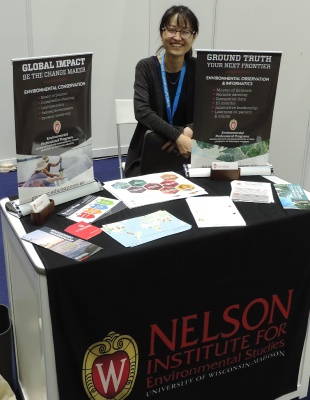As a senior researcher at the Research Center for Endangered Species National Institute of Ecology in the Republic of Korea, Nelson Institute alumna Anya Lim works on a wide variety of conservation planning projects. Whether the project involves Amur gorals or Chinese pond turtles, Lim utilizes the skills she gained at the Nelson Institute, specifically applying her knowledge in Open Standards for the Practice of Conservation (Conservation Standards), to plan and measure the success of these projects.
In fact, Lim is among the first to apply the Conservation Standards in Korea and recently worked with colleagues to publish a Korean version of the Conservation Standards introduction book last year.

While the Conservation Standards were developed by the Conservation Measures Partnership (CMP) in 2004, the Nelson Institute has long utilized these standards and integrated them into the curriculum for graduate and professional students. This year, the Nelson Institute will launch the online course Conservation Essentials in collaboration with specialists from CMP, Conservation Coaches Network (CCNet), and Foundations of Success (FOS). The course will teach the Conservation Standards and be open to graduate students and practitioners around the world.
“I’m using what I learned and taught as a teaching assistant for the Conservation Planning course at the Nelson Institute,” Lim said of her work. “Particularly, I am applying the Conservation Standards for my two current projects. Plus, I am still involved in the [Nelson Institute] conservation planning course as a project representative at this time. Last year, I brought the Eurasian Otter conservation project to the class and this year I will bring the Asiatic black bear reintroduction project.”
For Lim, the Asiatic black bear project is an exciting professional opportunity. Originally led by the Ministry of Environment and the National Park Service, the Asiatic black bear reintroduction project planned to secure 50 black bears in Jiri Mt. National Park by 2020, but the goal was achieved in 2018. Lim is now working on developing a conservation plan for the second phase of the bear project 2021 through 2030 in collaboration with the National Park Service.
“By far, the reintroduction project has focused on the black bear population,” said Lim. “However, we are trying to move the focus from species to the habitat, from reintroduction to monitoring, and from top-down conservation to a bottom-up approach.”
In addition to Asiatic black bear reintroduction, Lim is also working on Amur leopards research and introduction in Korea. For the research, she is working with the Land of the Leopard National Park in Russia, which has the last and most Amur leopards in the wild.
“We are in the very early stage of collaboration. Right before the COVID-19 crisis started, we visited the Land of the Leopard National Park and joined the law enforcement patrol and Amur leopard monitoring,” said Lim. “We hope to contribute in-situ Amur leopard conservation. We are also working to introduce Amur leopards in captivity to the center – bringing the lost prince to Korea. We are preparing to build a natural rearing center which helps to rewild the captive leopard to participate in the ex-situ conservation.”
For Lim, the leopard reintroduction project is particularly meaningful because leopards are what originally inspired her to get involved in conservation.
“During my junior year at the university, I was absent from school for a semester. During that time, I visited the local zoo to refresh myself and I saw this beautiful creature lying down on the tree branch. Of course, I had seen leopards many times on a TV but watching the real one was very different. I would say I fell in love at first sight,” Lim said. “When I came back home, I Googled it and learned their tragic history. Amur leopards (Panthera pardus orientalis) flourished across the whole Korean Peninsula until the early 20th century. However, going through the Japanese colonial area (1910 to 1945) leopards were heavily poached.
“Then, the Korean War (1950 to 1953) destroyed the whole peninsula, the habitat of the leopards. The few leopards left eventually extirpated from South Korea in the 1970s. Although Amur leopards were gone from South Korea, about 30 of them survived in the Russian Far East bordering with China and North Korea. As a Korean, I felt responsible for their extremely endangered situation and wanted to do something for them.”
That interest in supporting Amur leopard conservation led Lim to complete her bachelor’s degree in biological sciences at the Korea Advanced Institute of Science and Technology in South Korea and apply to the Master’s program for Global Environmental Change and Policy at the Centre for Environmental Policy, Imperial College in London. Soon after graduating with her master’s degree, Lim came to the Nelson Institute to complete her Ph.D. in Environment and Resources.
“While studying different conservation cases both failures and successes, I thought human-wildlife conflict is the key to wildlife conservation,” Lim said. “Thanks to the flexibility of the curriculum and interdisciplinary environment [at the Nelson Institute], I comfortably acquired knowledge and skills to understand local people in conflict with carnivores. That is how I got involved in wildlife conservation!”
As Lim continues her conservation work, she says she often reflects on the lessons she learned at the Nelson Institute, but also the connections she made that continue to fuel her passion for conservation.
“I need to mention the Nelsonees – my friends, professors, and the staff who made my days in Madison,” Lim said. “They are the strong glue between me and the Nelson Institute.”